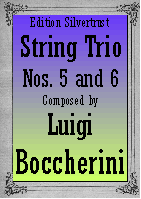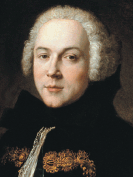Presents
Luigi Boccherini
|
String Trio No.5 |
 |
 |
String Trio No.6 |
String Trios for Violin, Viola & Cello
No.5 in E flat Major & No.6 in F Major, G.99 & 100
Boccherini wrote over 70 string trios, however, all but a dozen or so are for 2 violins and cello, rather than what became the standard combination of violin, viola and cello. Trio Nos. 5 & 6 are the last two of a set of six which were published together as his Op.14 in 1772. He was then at the height of his powers. In these trios, the roles and importance of each instrument is constantly varied. While the viola is often the glue between the violin and the cello, at times, it becomes the the soloist. But in these trios, it is the cello that is given a leading role much of the time. The writing spans the entire range of its registers, hopping from deep in its bass to high in its treble clef and requires the extensive use of thumb position.
Luigi Boccherini (1743-1805) was born in the town of Lucca in northern Italy. He studied cello and became a virtuoso. But it was at a time that such players could not yet make a living from touring, so Boccherini found jobs in various orchestras in Vienna and Italy. Boccherini eventually moved to Paris where he hoped to establish himself as an independent soloist and composer but could not and was forced to take employment with the Spanish royal family for the rest of his life.
Boccherini was a very prolific composer writing for virtually every genre which then existed. As a string player, he knew how to make string instruments sound their best. His chamber music shows him as one of the great pioneers of instrumental technique, especially for the cello. He and Haydn were regarded as the two finest composers of third quarter of the 18th century. While today the string quartet is the “King” of chamber music ensembles, during the last half of the 18th century, the string trio was the most popular chamber ensemble and virtually all of the active composers lavished their talents on them. Haydn, Pleyel, Giardini and Mozart, to name but a few, all spent time and effort writing trios.
|
Notes to String Trio No.5 |
Notes to String Trio No.6 |
|
Trio No.5 is in three movements. The first movement, Andantino, begins in a gentle fashion with a gracious melody, similar to No.4, but here the upper voices rather than the cello is given the lead. A constant pulsations propels the music. The following Allegro con spirito is a lively affair--light and quick. The third movement, Allegretto sostenuto, is a theme and set of variations. The theme is quite simple, but is rhythmically quite interesting. The tempo is relaxed but deliberate. The variations each have different moods, some quick, some slow. |
Trio No.6 is also in three movements. It opens with a lovely Larghetto. The mood is sedate, at times wistful. Next comes an exciting Allegro. The music races along at a breathtaking pace. As the Allegro progresses, it takes on rustic quality. The finale, Rondo con moto, as in Trio No.5, is more relaxed. It is a dignified rococo dance, much like a minuet. However, the second section much quicker than the traditional minuet. |
These trios are among the finest in the classical literature little gems which we believe professional and amateur trio groups will greatly enjoy.
Trio No.5 Parts: $19.95 / Trio No.6-Parts: $19.95
Special Offer: Both Trios: $29.95